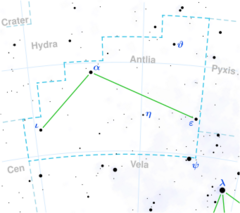Astronomy:Eta Antliae
| Observation data Equinox J2000.0]] (ICRS) | |
|---|---|
| Constellation | Antlia |
| Right ascension | 09h 58m 52.27552s[1] |
| Declination | −35° 53′ 27.4977″[1] |
| Apparent magnitude (V) | 5.222[2] |
| Characteristics | |
| Spectral type | F1 V[3] |
| U−B color index | +0.068[2] |
| B−V color index | +0.333[2] |
| Astrometry | |
| Radial velocity (Rv) | +30[4] km/s |
| Proper motion (μ) | RA: −89.782[1] mas/yr Dec.: −16.245[1] mas/yr |
| Parallax (π) | 30.0606 ± 0.1080[1] mas |
| Distance | 108.5 ± 0.4 ly (33.3 ± 0.1 pc) |
| Absolute magnitude (MV) | +2.62[5] |
| Details | |
| η Ant A | |
| Mass | 1.55[6] M☉ |
| Radius | 1.72[1] R☉ |
| Luminosity | 6.6[6] L☉ |
| Surface gravity (log g) | 3.94[3] cgs |
| Temperature | 7,132[3] K |
| Metallicity [Fe/H] | −0.20[3] dex |
| Age | 0.9[6] Gyr |
| Other designations | |
| Database references | |
| SIMBAD | data |
| Database references | |
| SIMBAD | data |
Eta Antliae (η Ant, η Antliae) is the Bayer designation for a double star in the southern constellation of Antlia. The brighter component has an apparent visual magnitude of 5.222,[2] making it visible to the naked eye. Parallax measurements of the system yield a distance estimate of 108.5 light-years (33.3 parsecs) from Earth.[1]
The main component has a stellar classification of F1 V,[3] which indicates that it is an F-type main sequence star. This star has 55% more mass than the Sun.[6] It shines with 6.6[6] times the Sun's luminosity at an effective temperature of 7,132 K.[3] This heat gives it the yellow-white glow of an F-type star.[8] It has a faint companion located 31 arcseconds away with an apparent magnitude of +11.3. Most likely this pair form a binary star system.[9]
References
- ↑ 1.0 1.1 1.2 1.3 1.4 1.5 1.6 Brown, A. G. A. (August 2018). "Gaia Data Release 2: Summary of the contents and survey properties". Astronomy & Astrophysics 616: A1. doi:10.1051/0004-6361/201833051. Bibcode: 2018A&A...616A...1G. Gaia DR2 record for this source at VizieR.
- ↑ 2.0 2.1 2.2 2.3 Gutierrez-Moreno, Adelina et al. (1966), "A System of photometric standards", Publications of the Department of Astronomy University of Chile (Publicaciones Universidad de Chile, Department de Astronomy) 1: 1–17, Bibcode: 1966PDAUC...1....1G.
- ↑ 3.0 3.1 3.2 3.3 3.4 3.5 Gray, R. O. et al. (July 2006), "Contributions to the Nearby Stars (NStars) Project: spectroscopy of stars earlier than M0 within 40 pc-The Southern Sample", The Astronomical Journal 132 (1): 161–170, doi:10.1086/504637, Bibcode: 2006AJ....132..161G.
- ↑ Wilson, Ralph Elmer (1953), "General Catalogue of Stellar Radial Velocities", Carnegie Institute Washington D.C. Publication (Washington: Carnegie Institution of Washington), Bibcode: 1953GCRV..C......0W.
- ↑ Anderson, E.; Francis, Ch. (2012), "XHIP: An extended hipparcos compilation", Astronomy Letters 38 (5): 331, doi:10.1134/S1063773712050015, Bibcode: 2012AstL...38..331A.
- ↑ 6.0 6.1 6.2 6.3 6.4 Mallik, Sushma V.; Parthasarathy, M.; Pati, A. K. (October 2003), "Lithium and rotation in F and G dwarfs and subgiants", Astronomy and Astrophysics 409: 251–261, doi:10.1051/0004-6361:20031084, Bibcode: 2003A&A...409..251M.
- ↑ "* eta Ant". SIMBAD. Centre de données astronomiques de Strasbourg. http://simbad.u-strasbg.fr/simbad/sim-basic?Ident=%2A+eta+Ant.
- ↑ "The Colour of Stars", Australia Telescope, Outreach and Education (Commonwealth Scientific and Industrial Research Organisation), December 21, 2004, archived from the original on 2012-03-18, https://web.archive.org/web/20120318151427/http://outreach.atnf.csiro.au/education/senior/astrophysics/photometry_colour.html, retrieved 2012-01-16.
- ↑ Eggleton, P. P.; Tokovinin, A. A. (September 2008), "A catalogue of multiplicity among bright stellar systems", Monthly Notices of the Royal Astronomical Society 389 (2): 869–879, doi:10.1111/j.1365-2966.2008.13596.x, Bibcode: 2008MNRAS.389..869E.
 |


